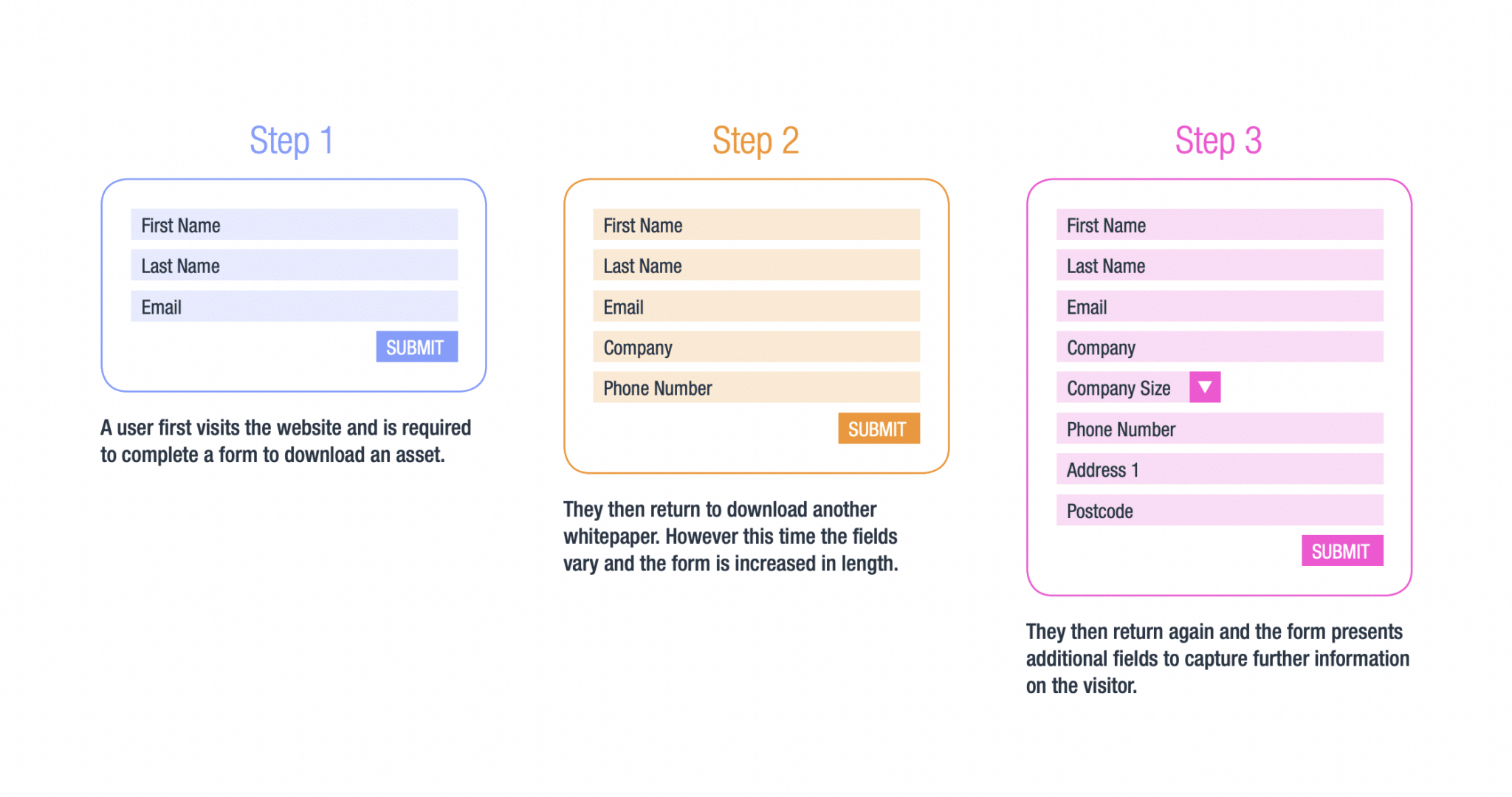The Ultimate Progressive Profiling Guide

What is progressive profiling?
A technical definition of Progressive Profiling is the process of incrementally gaining additional data on a contact through subsequent form submissions. This usually occurs in exchange for value, passing through a form to access some gated content.
Put simply, prospects give you more information about themselves the more they visit your site and access content.
Marketing Automation platforms have long had this functionality. However the actual execution can vary significantly, which has led to confusion as to what progressive profiling is and how it works.
This article will give you a comprehensive overview, dispel some common misconceptions and hopefully set you on the path to enhancing your content gating experience and conversion rates.
A progressive profiling example

Why is progressive profiling useful?
Progressive profiling should be seen primarily as a benefit to the user.
By lowering the volume of data required in the early stages of engagement, you create a better value exchange, which not only builds trust with your audience but also improves your future engagement opportunities.
Each additional field on a form effectively creates a higher barrier to completion thus increasing the form abandonment rate. The upshot is that users do not access the desired content (which is bad for the user) and you do not capture the contact to enable future engagement (which is bad for your business).
The question could be posed “why gate at all, or why not always use short forms?”. For transactional sales models a “no-gate” content strategy can work, but where buyer journeys are complex and sales processes are longer, B2B businesses need to build contact profiles to enable segmentation and targeting by industry, persona or company type.
Who defines the progressive profiling strategy?
Strategically, progressive profiling initiatives should always be led by marketing rather than technology.
Whilst technology is fundamental in implementing progressive profiling, and it is clearly important to be aware of any technical limitations, the strategy must be driven by a marketing requirement. For this reason, this guide largely focuses on strategy, the benefits and the different methodologies, rather than platforms that enable progressive profiling.
Common progressive profiling deployments
The most common deployments adopted are:

All of these methods have benefits and potential drawbacks for you as a business; there is no single best-practice approach. Indeed in some instances it may be that a combination of the above methods is strategically appropriate.
Note that progressive profiling usually sits outside the ‘Contact Us’ form structure where there is a minimum data requirement for effective follow-up.
Deployment method 1: Content value
A common misconception of this deployment type is that it is in fact not progressive profiling. The progression is created through different levels of gating (eg. Low, Medium and High) and whenever you gate an asset you assign an appropriate level to it.
An example may be...
A high gate on an analyst whitepaper or a low gate for a subject matter expert interview video. The high gate may ask for full contact details (name, phone, email, company, address, sector etc.) whereas the low gate will only have basic details for subsequent future communications (name and email).
Reasons to use this method
- Understanding of the methodology is straight-forward and easy to explain across a business
- Content creators and campaign planners maintain ‘control’ over the gate value of their asset (this is especially useful in large, diverse organisations
- Assets that have a high utility (analyst papers, legislation guides etc.) can be controlled to always have a gate aligned to this value
- Easy to align to the buyer journey and user lifecycles
- Easy to build and deploy
Considerations against this method
- May also be seen as not putting the user first because you are aligning the gate level with the businesses perception of the content value
- Does not factor how familiar the user is with your business
- Challenging to build up deeper/niche fields as the form becomes too long to be functional or to convert well
Quick start steps
- Define overall form requirements (usually easiest to start with a high gate and determining what is required for sales to follow-up)
- Rationalise how many levels of forms you require and what fields would be appropriate at each level
- Build ‘standard’ forms, communicate your standards to the business
- Determine a governance process to reduce the risk of deviation from your standards
Overall, this is a great place to start progressive profiling because implementation is often straight-forward and the method allows a high level of control over the fields required for high value assets.
Deployment method 2: User engagement/profile
This method works by presenting the user with additional/different fields based on the number of times they have submitted forms.
In effect, there is a series of pre-defined sequential forms presented to the user each time they wish to access content. The fields can be added incrementally (usually at the end of the previous form fields) or can replace fields to keep the length of the form shorter.
An example may be...
The user provides an email and name on the first form submission when downloading a guide. The second form then asks for company and phone number and the third asks for industry and company size. The fourth submission may require job title. For platforms such as Eloqua, Marketo and Hubspot this is commonly how progressive profiling works.
Three variants in how this can be deployed:
A: Progression by user profile
This method of defining the progression is based on how much data you already hold for a contact. If the required data is already held in your data platform, fields can be pre-populated or the next level of form progressive can be presented.
This is probably the most robust and integrated way of deploying progression and also delivers a great user experience because steps can be skipped for mature user profiles.
B: Progression by lead score
This is similar to method A but is based on a lookup of the contact’s lead score. This works well in understanding the user’s current level of engagement but may not always align to the existing profile data held on record.
Users may be asked for information that isn’t needed because it is already known, or conversely a field isn’t presented but the data is critically required for subsequent engagement or sales follow-up.
C: Progression by submission volume
This method simply progresses people for each subsequent form submission regardless of data collected.
This can be simpler to map out and potentially build, but provides a very defined linear user journey through forms which may not accelerate them if data is already known on a contact.
The method of progression possible will also depend on the scale of the planned roll-out, maturity of the website infrastructure, the marketing automation platform and the level of technical skills available.
Customisation
With some additional development the engagement/data method also lends itself to a degree of customisation.
Some examples may be that after a submission all gating forms are removed (or “opened”) for 24 hours or, only applying progressive steps across specific pages or content assets. These customisations can optimise the user experience and improve conversion performance.
Reasons to use the engagement/data method
- New users are presented with low gates which improves conversion rates
- Good at widening top of funnel engagement, especially if nurturing programs are in place to then drive repeat visits
- Nice user experience with low level gates that allow you to build trust and data over time
- Allows data fields to get very specific at later levels of progression
Considerations against this method
- More complex to explain across a business
- Content creators and campaign planners lose ‘control’ over the gate value of their asset
- Assets that have a high utility (analyst papers, legislation guides etc.) can be accessed at a lower level which does not align to the perceived business value
- Management of sales expectations is critical as contacts will commonly need to complete multiple forms in order to have all required data fields for follow-up
Quick start steps
Deployment method 3: Dynamic profiling
Dynamic profiling is the process of refining questions (and data fields) based on your increased understanding of an individual contact.
To be effective it requires integration with a contact data record lookup in Marketing Automation, CRM or CDP.
An example may be...
When a user encounters a form for the first time they are asked if they are an existing customer, partner or interested party. Subsequent questions could then be tailored to each audience type.
An alternative use case could be on the first submission you ask a user for their job function, on their return visit you could ask an HR professional how many people are on their payroll whereas someone in IT is asked about the number of devices they manage.
Currently, Marketing Automation platforms do not natively have this level of functionality. This kind of profiling would require bespoke development or a third party solution.
Reasons to use this method
- Provides a comprehensive data strategy including required/desirables fields across the business
- Hugely user centric by tailoring the relevancy of questions asked
- Builds out the most appropriate data for different audiences faster than other methods
- Allows capture of very niche and specific data points
Considerations against this method
- Needs significant investment of time, planning and resources to implement
- Needs deployment globally at scale across the business to be effective
- Content creators and campaign planners lose ‘control’ over the gate value of their asset
- Assets that have a high utility can be accessed at a lower level
This is technically the most complex method to deploy and may only be suitable for some sales models e.g. an enterprise selling many different products to different personas.
Planning and executing progressive profiling
- Identify all data fields required across the business
- Work with stakeholders to determine the importance of each data point and how they align to the sales and marketing process
- Determine the scale of roll-out and if a global approach can be adopted
- Audit your content and determine the different levels of value to the user
- Determine the technical capabilities of your infrastructure and team
- Gain business alignment on the chosen progression approach
- Develop and document your progression strategy
- Build and implement the progression leveraging native functionality, bespoke development or a third party solution (e.g. Formulayt)
Conclusion
Progressive profiling can seem like a complex technical project to deploy but it need not be. Start with the marketing needs of the business and the desired user experience and work backwards from there. Always consider the maturity of your business and the available technical resources.
The most challenging area will be achieving stakeholder alignment across your business. Once you achieve this, determining the best technical deployment will be more straight-forward.
Be sure to work within the natural capabilities of your infrastructure. A bespoke development may seem appealing, however it will likely take longer to get to market, result in more maintenance and may not provide a solution as robust as something more native.
For advanced off-the-shelf progressive profiling consider a form management platform (such as Formulayt).
How much you could improve
your web conversion by?
By analyzing your current web conversion rates and optimization practices, we can estimate the projected uplift in leads you can expect from working with Formulayt.
You may be interest in these article next
Double the ROI on Your Marketing Tech Stack
Too often, marketers focus on the deployment of a shiny new tool rather than focusing on maximizing the return on the tools they already For example, a company interested in increasing leads from their website might dedicate a sizeable portion of their marketing budget towards driving traffic from advertising. However, all the traffic in the…
How Form Inconsistencies Contribute to Data Hygiene Problems
Businesses have learned the importance of collecting data, but many are still unaware of how difficult it is to use if not governed properly. Here’s how to maintain data integrity.
How to Scale a Global Marketing Team
To organizing marketing data, the capturing of leads and collection of lead data needs to be carried out efficiently. However, creating web forms and landing pages can be challenging when you factor in the ever-growing needs of local marketing teams.



